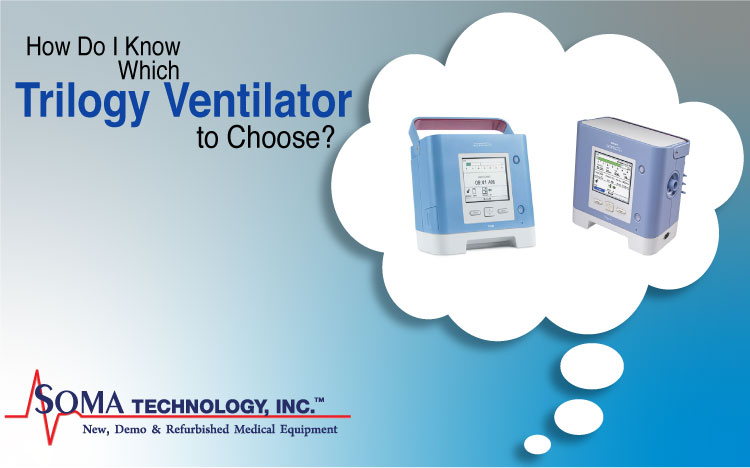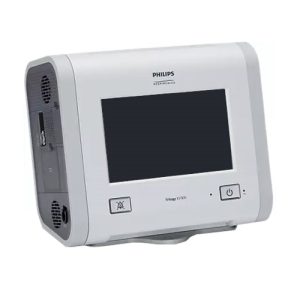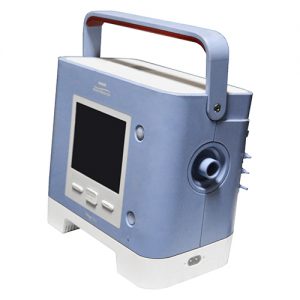How Do I Know Which Trilogy Ventilator to Choose?
September 20, 2019
How Do I Know Which Trilogy Ventilator to Choose?
Soma Technology offers a wide range of medical equipment to outfit hospitals, even including rental equipment. Our sales representatives frequently outfit biomedical engineers and equipment planners with the right equipment for them, including ventilators. Interestingly enough, the fall and winter seasons are when there are the most ventilators purchased because this is when diseases that affect the respiratory system occur the most frequently. Continue reading to find out which of the Philips Trilogy ventilators can work for your medical facility, and to learn about the common ailments that rely on ventilators.
 Philips Respironics Trilogy 100 Ventilator
Philips Respironics Trilogy 100 Ventilator
Philips is a very well-respected brand that continues to sustain a juggernaut status as one of the leading medical equipment manufacturers in the world. This Trilogy 100 ventilator is one of the most widely requested ventilators that Soma refurbishes. this ventilator is used by patients who require mechanical ventilation and can be used by any patient who is over 11 pounds. Any patient can use this device in their home, or physician’s office, or can be used in a hospital setting. This unit can be used with other Philips Respironics patient circuit accessories including interface devices, humidifiers, water traps, and circuit tubing. Features on this unit include a screen that is easy to read, two circuit options for simple and flexible use, and a passive circuit option for passive exhalation. Other features include proven non-invasive therapy with digital auto-track, a direct view ventilation management reporting software, and the ability to give volume targeting options with AVAPS-AE. This unit comes with an ergonomic handle and is easily transportable between patient rooms by weighing only 11 pounds.
 Trilogy Ventilator – Respironics Trilogy 202
Trilogy Ventilator – Respironics Trilogy 202
The Trilogy 202 ventilator is the next model in the series. It is slightly larger at about 12.3 pounds. This unit also can be easily transported between patient rooms with a handle. The Trilogy 202 features the ability to compensate for leaks in volume and pressure controls and can use simpler passive circuits that support significant time and cost savings. Other features include a compact design with a long internal battery life, active and passive circuits for both invasive and noninvasive ventilation, and innovative leak-compensated volume control ventilation. The design of this ventilator specializes in intra-hospital transport, allowing freedom of movement, and an optional three-hour battery that can detach. The Respironics Trilogy has a secure digital card slot that can store ventilator data. This data can later be used to review trends and identify potential new courses for treatment.
Types of Conditions that Require Ventilators
There are many reasons why someone would need to be on a ventilator. Some people suffer from respiratory failure, and cannot breathe on their own. Sometimes when people are unconscious or in a coma, they also can not breathe on their own. This requires them to need an assisted apparatus for breathing. These patients would most likely be using invasive ventilation. People who need more airways into their lungs, like those with the flu, bronchitis, or pneumonia, would be using a noninvasive ventilator that fits over their mouth and nose to assist in getting oxygen into the lungs.
The Flu
Everyone knows that flu season has started! It is notorious for starting right around the time that children go back to school. Symptoms of the flu include muscle weakness, tiredness, headaches, muscle aches, and general cold symptoms. Complications of the flu can lead to bronchitis and pneumonia which can affect the respiratory system. Also, it is a good time to go get your flu shot!
Bronchitis
People who are diagnosed with bronchitis have bronchi tubes that are inflamed. This makes it hard to breathe and symptoms also include fever, chest tightness, and wheezing. When the mucus is coughed up, it can make breathing very hard. Physicians may place people with bronchitis on ventilators to make it easier to breathe.
Pneumonia
Pneumonia is a condition in which air sacs in the lungs are inflamed. The lungs are filled with fluid that makes it hard to breathe. Many people with pneumonia are placed on ventilators so that they can be assisted in having oxygen flow into their lungs.
Purchasing a Ventilator from Soma
If you have read this article and are interested in purchasing a ventilator or one of the trilogy ventilators, you can contact your sales representative. Our sales representatives have training in helping customers to decide what equipment they need for their medical facility. Soma Technology sells much more than just ventilators. We sell many units to outfit your ambulatory surgery center, physician’s office, and clinic as well! Take a look at our website to see if any of these pieces are something that you can use your capital medical equipment budget for. Now is a good time to remind you that Section 179 allows your medical company to take up to 1,000,000 in tax write-offs for up to 2,500,000 if that was spent in the fiscal year of 2019. Please call 1-800-GET-SOMA, or email [email protected] for more information or to request a quote.
Requesting Spare Ventilator Parts
Most of our equipment comes with a one-year warranty on parts and service. However, if you already have this equipment, we do have a division of parts. We have many spare ventilator parts and even more spare parts for all of the different types of units that we sell. Please email info@somamedicalparts for a quote, or visit www.somamedicalparts.com to directly purchase from our website. If you would like to call, please dial 1-860-5781033.
The Refurbishment Process
All of the refurbished items that Soma Technology go through an extensive process to bring them back to the original equipment manufacturer’s specifications. First, the procurement department sources the best and most trending equipment. The equipment is then reviewed by our highly trained biomedical engineers who replace necessary parts and calibrate the machines back to the original equipment manufacturer’s specifications. Next, the units are sanded and painted in our cosmetics department. New stickers and decals are placed on the machine and the machines are sent back to engineers. Our biomedical engineers calibrate the machines again and double-check that they are in working order. Shipping packages the units to be safely transported to your medical facility for immediate use.
Final Thoughts
Have you ever used a ventilator, or taken steps to purchase one? Were there significant features that you wanted standard on a ventilator? Is there a brand of ventilators or medical equipment that you find to work the best or ones that you choose over and over again to purchase? Have you ever spoken to one of our sales representatives about choosing medical equipment? Comment below!
Explore Other Blog Items By Category
Recent Posts


Surgical Microscope Rentals

